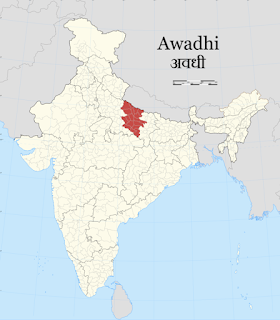 |
| Begum, Hazrat Mahal,facebook.com |
 |
| Ahmedabad diamond,famousdiamonds.tripod.com |
 |
| Awadh kingdom. wikiwand.com/ |
The 17th century Ahmedabad diamond, one of the beautiful diamonds from the former Kollur mines of Andhra, was first named by Gemstone expert Edwin Streeter in his book World famous diamonds. The first purchaser was an international diamond expert, trader and traveller Jean Tavernier. He had it cut in Ahmedabad itself for a mogul royalty.
In the later years in the middle of the 19th century CE, there was a drastic change in the political scenario dominated by the East india company whose hegemony in every field in the subcontinent pushed the oppressed indians beyond the fag end of patience primarily caused by over exploitation of indian natural resources and land grabbing spree from the Maharajahs and Nawabs. This persistent frustration led to the great rebellion of 1857 and from Meerut it snowballed into a violent rampage.
At that point of rebellion Begum, Hazrat was in possession of the Ahmedabad diamond. After her, the record is not clear about the ownership. Oudh was annexed by the British in 1856. Hazrat Mahal begum was an outspoken rebel leader at the time of the Mutiny. Infuriated over the injustice done to her husband she took openly rebelled against the British. She never failed to prove her valor, wisdom and fighting qualities in the battle field. To her freedom was the foremost one.
 |
| Begum hazrat Mahal, muslimmirror.com |
Above image: Begum Hazrat Mahal, the unsung woman heroine of 1957 first war of independence..............................
However, when British forces, after a long struggle, regained control over the rebellion after the fall of Delhi siege in Sept 1857 Hazrat Mahal along with her son and a group of followers under adverse circumstances in 1859 fled to Nepal. The authorities after long deliberations, gave her asylum on condition that she should not communicate with the rebel leaders or people in India. He son fell sick and this caused additional burden to her. The British authorities allowed her to return to India on certain conditions. She refused to surrender and accepted the terms and conditions as the English company and the Crown were not reliable and would cause her all sorts of troubles. She rejected the life of special privileges and comfort offered by the British.
Finally, Begum Hazrat Mahal, the rebel warrior, lived in Nepal in exile for 20 years till her death on 7 April, 1879. She took no less “active part in the defence” of Lucknow city against the British, according to the book “Freedom Fighters of India” edited by M.G. Agrawal. Her tomb is situated at Jame Masjid in central Kathmandu and the Indian government holds a memorial service every year there.
With a view to returning to India to fight against other forces against the British, at one stage Begum Hazrat Mahal was keen to use the Ahmadabad diamond as a bargaining chip to get favors for safe passage to India. But as she was sceptical about the integrity and trustworthiness of the English official, she never returned to India. According to many historians, the above information appearing in some posts needed authenticity and it was not true. Being a daring woman she won't stoop to a low level to bribe the corrupt british officials.
As for Ahmedabad diamond, apparently it was owned by one of the Mogul members for whom Tavernier bought it. How the queen of Oudh came into possession of the famous diamond is not clear
After Hazrat Mahal death in 1879, the story of Ahmedabad diamond and its whereabouts became a subject of discussion and postulation. There was a big gap in its history. Nobody knows who was or were the owners between 1859 and till 1955. Where was the diamond in the long gap in history? Was it privately owned or held in a museum secretly? There is no possibility that the diamond had disappeared completely during the long hiatus. How come the present weight is is lighter than that of the early recorded weight of 90.5 carats ? Such reduction may be explained by its transformation from a briolette to a pear shape cut. But the fact that this gem possesses a minor flaw at its base is a surprising one.
Robert Mouawad, present owner got it for approximately US $ 4.3 million. The current value of the diamond is greater than $ 5.0 million. The jeweller bought it at an auction held by Christie in 1995. Ahmedabad diamond named by Edwin Streeter (vide his book) was first purchased by Frenchman Tavernier, but its long history is a chequared one and missing are intermittent owners.
The 17th Century trader of precious gems discovered the famous phenomenal 115 carat blue diamond which later became the French Blue and, ultimately, the Hope Diamond. The passion for gemstones drove the Frenchman to far off mystic lands where no foreigner had gone before. Tavernier’s daring exploits with single mindedness covered thousands of miles. That this rare diamond that was bought by Tavernier himself in Ahmedabad for the Mogul royalty has incomplete chronology is unfortunate!!
https://www.rediff.com/money/slide-show/slide-show-1-the-worlds-most-beautiful-diamonds/20090616.htm
https://ddnews.gov.in/international/wreath-laying-ceremony









